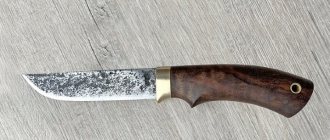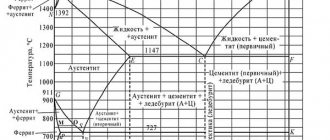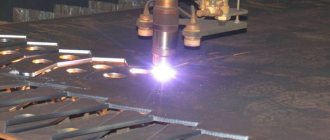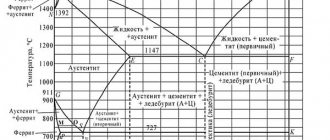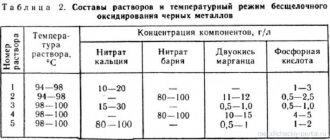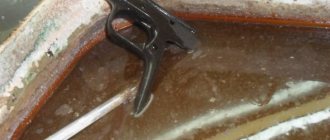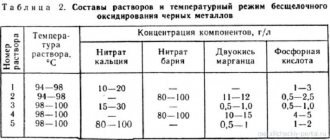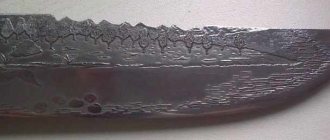Previous article: Forging metal at home - part 1. Properties of metal
Forging metal at home is a real art for the home craftsman, comparable to the art of an artist, in which you can practice and improve endlessly. First of all, you will need to acquire the necessary tools for blacksmithing and equip a special place for a forge, or even make a permanent forge. However, even if you have the forge itself and all the necessary accessories for the forge, blacksmithing also requires additional knowledge regarding the entire forging process.
State diagram of iron-carbon alloys
It is convenient to determine the structure and temperature of phase transformations of steel at different temperatures from the phase diagram. In Fig. Figure 1 shows a section of the iron–carbon phase diagram for steel. Each point on the diagram corresponds to its own steel composition and a certain temperature. This diagram is extremely important for the informed choice of thermal conditions for all types of hot forming, including heat treatment of steel.
The AC line is called the liquidus line. Above this line the alloy is in a liquid state. Line AE is the solidus line; it indicates the temperatures corresponding to the end of the primary crystallization of the alloy. Below this line, the alloy is in a solid state, for example with the formation of a body-centered cubic crystal lattice.
The process of secondary crystallization of the alloy in the solid state (for example, the transformation of a body-centered crystal lattice into a volumetric face-centered cubic lattice) ends on the PSK line, called the eutectoid line, or the line of lower critical points A1. Critical points are the temperatures at which structural transformations occur in the steel in the solid state.
The beginning of the process of secondary crystallization of the alloy from the austenite solid solution is determined by the GSE line. The GS line shows the temperature at which ferrite begins to precipitate from austenite. It is also called the line of upper critical points A3. The SE line corresponds to the temperature at which secondary cementite begins to precipitate and the limiting solubility of carbon in austenite. It is also called the line of upper critical points Am. The critical points for cooling are designated Ar, and for heating, Ac.
The regions of existence of solid and liquid phases, as well as various structural components with a schematic representation of the microstructures of steel are shown in the diagram (Fig. 1). According to the diagram, steel containing 0.83% carbon is called eutectoid; it has a pearlite structure.
Rice. 1. Part of the state diagram of iron-carbon steels and temperature ranges for forging and stamping
Steel containing up to 0.83% carbon is called hypoeutectoid; its structure consists of ferrite and pearlite. Hypereutectoid steel contains >0.83% carbon and its structure contains pearlite and secondary cementite.
The most plastic structure is the austenite structure. If there is a two-phase structure in the alloy, its plasticity decreases. Low-carbon and carbon steels at temperatures of 1100...1200 °C have only an austenitic structure. Due to high ductility, a temperature of 1200 °C is taken as the upper limit of the forging temperature range for carbon steel. High-carbon steel at a temperature of 1100 °C has a two-phase structure: austenite + cementite, the latter forming a brittle network along the grain boundaries.
To increase the ductility of steel, it is necessary to crush this cementite network so that the cementite forms individual grains in the metal of the workpiece. At the same time, the hardness and strength of the metal remain high. It is advisable to take the upper limit of forging temperatures for high-carbon steel as ~1100 °C. In this case, forging must be carried out with precautions, taking into account that ductility is reduced due to the two-phase structure.
Using the phase diagram, you can also select the lower limit of forging temperatures, which should lie above the temperatures of phase transformations. It should be noted that low-carbon steels can also be forged with ferrite + austenite structures due to their fairly high ductility.
Hypereutectoid steels have a lower limit of forging temperatures in the austenite + cementite zone. This temperature should be as low as possible to prevent the formation of a cementite network.
The maximum range of forging temperatures becomes narrower with increasing alloying elements in the steel. If for carbon steels it is ~500...600 °C, then for structural alloy steels ~330 °C, for heat-, acid-, and corrosion-resistant steels ~260 °C, for heat-resistant steels ~200 °C, and for heat-resistant alloys ~150 °C.
When establishing the lower limit of forging temperatures, it is necessary to take into account the mass of the forging, the presence or absence of subsequent heat treatment, and the cooling method.
The effect of heating on the structure and mechanical properties of steel
As the heating temperature of a metal increases, the mobility of its atoms increases, causing a number of complex physical and chemical processes to occur. The dynamics and nature of changes in some mechanical properties of the material depending on the heating temperature using low-carbon steel as an example are shown in Fig. 2, from which it can be seen that with an increase in temperature in the region of 200...300 °C, the strength of the metal increases with a simultaneous decrease in ductility. This is the zone of blue brittleness. With a further increase in temperature, the strength of the metal, and therefore the resistance to deformation, continuously decreases. At the same time, the increase in metal ductility in the temperature range 700...800 °C decreases again. This is explained by structural transformations, during which the metal consists of two dissimilar structures characterized by unequal mechanical properties.
When the metal is heated above temperatures of 1100...1200 °C, the growth rate and size of austenite grains sharply increase, which become larger the longer the heating time. This phenomenon is called overheating , and the metal itself with excessively large grains is overheated . The temperature after which intensive steel grain growth and overheating begin is called critical. For carbon steel with a carbon content of up to 0.4% it is 1300 °C and >0.4%
Rice. 2. Change in the mechanical properties of low-carbon steel when heated: 1 – relative elongation δ;
2 – ultimate strength of carbon 1150 °C. A metal with an overheated structure is characterized by reduced plastic properties; during forging, cracks may form, and after forging, the product will have reduced mechanical properties. Overheating is a defect in the heating of the metal. In most cases, it is corrected by subsequent heat treatment (annealing).
When heated to temperatures slightly lower than the melting point [AE curve on the iron–carbon diagram (see Fig. 1)], a sharp decrease in ductility is observed, which is the result of significant grain growth and subsequent burnout of the metal, characterized by oxidation of grain boundaries. The oxides formed along the grain boundaries have a lower melting point than the metal grains, the grain boundaries begin to melt, and a complete loss of ductility of the heated metal occurs. Overburning is an irreparable defect that can only be eliminated by remelting the metal. The burnout temperature for some grades of carbon steels is: for steels 20; 45; U8 and U12 respectively > 1350; 1350; 1200 and 1200 °C.
If the heating time is insufficient, the metal does not have time to heat up evenly over the entire cross-section and has lower ductility in the central zone of the workpiece. Deformation of underheated metal leads to the emergence of significant internal stresses and, when processing a workpiece by forging or stamping, can lead to the formation of cracks in the axial zone of the workpiece.
Hot steel forging technology
Forging begins with heating the workpiece in a muffle furnace or forge, then the hot metal is sprinkled with forge flux. When processing steel, the following operations are performed:
- according to the required dimensions, the red-hot semi-finished product is divided into parts;
- cutting is carried out - external processing of the surface of the workpiece;
- excess fragments are cut off from the metal, resulting in a rough version of the product;
- drawing is performed, after which the workpiece becomes longer and narrower;
- using special tools, holes of various shapes are punched;
- if required, the workpiece is given the desired bend using a template (or without it);
- at the final stage, after additional operations, finishing is performed.
During hot forging, upsetting, upsetting, broaching, rolling, rolling, piercing and straightening are performed. As sedimentation work progresses, the workpiece increases in cross-section and decreases in height. When planting, a thickening is made on the surface. In this case, the length of the semi-finished product is also reduced. Broaching is another blacksmithing technique in which the workpiece is lengthened and thinner.
During rolling, the heated material takes on a cylindrical shape: during hot forging of this type, the workpiece is wrapped around its axis. Rolling involves processing a ring-shaped semi-finished product, which changes its internal and external diameters during processing. As it accelerates, the metal object becomes wider.
Attention: Firmware is an operation that produces a through hole using a punch.
Heating mode of blanks for forging and stamping
The heating mode of the workpieces determines the conditions necessary for the production of high-quality forgings or stampings. It includes the following main parameters: furnace temperature when loading workpieces, speed or duration of heating of the metal, final heating temperature, holding time at a given temperature, total heating duration. The determining factors when choosing a heating mode are the chemical composition of the metal and the dimensions of the heated workpieces.
The temperature of the furnace working space is set depending on the grade of steel, the size and shape of the heated workpieces. The vast majority of billets made of structural steel, having a diameter or square side of up to 100 mm, are loaded into a furnace at a temperature of 1200...1300 °C. To ensure maximum productivity of the stamping unit (hammer, press, etc.), minimal losses of metal through waste and the formation of scale, as well as a sufficiently high temperature for the start of stamping, the metal is heated at the maximum permissible heating rate (temperature pressure). The heating rate is determined by the increase in the temperature of the workpiece metal in degrees Celsius per unit of time, for example, per minute or hour. It depends primarily on the temperature of the furnace working space, the thermal conductivity of the metal, its heat capacity, density, as well as the cross-sectional area of the workpieces and the method of arrangement of the workpieces in the furnace.
Thermal conductivity is the ability of a substance to conduct heat from more heated parts to less heated parts. The thermal conductivity coefficient shows how much heat (joules) passes in 1 hour through 1 cm2 of a body section with a temperature difference of 1 K at a distance of 1 m. Pure iron has a thermal conductivity coefficient λ = 86 W/(m K), alloy steel 3Х2В8Ф - coefficient
λ = 10.6 W/(m K).
The magnitude of thermal conductivity when heating a metal is important for establishing technological parameters for heating processes of workpieces. Metals and alloys with high thermal conductivity can be heated at a higher speed, since the heat from the surface of the workpieces received from the heating device will be transferred to the metal core intensively and the entire workpiece will warm up quickly enough.
Heat capacity is the amount of heat absorbed by a body when heated by 1 K; the heat capacity of a metal depends on its chemical composition and temperature. The higher the heat capacity of the metal, the longer it takes to equalize the temperature across the cross section of the heated workpiece. With increasing temperature, the heat capacity of carbon steels increases. Alloy additives in steel or alloy reduce thermal conductivity. This circumstance affects the heating time of the workpieces. For example, it is recommended to take the time of holding a workpiece in a furnace from the moment the metal reaches stamping or forging temperature from the following calculation.
1. For structural alloy steels: 1 min for every 4 mm of diameter (thickness) of the workpiece. (The maximum residence time in the furnace at the stamping temperature of workpieces with a diameter or square side of up to 250 mm should not exceed 1...2.5 hours.)
2. For heat-resistant, acid- and corrosion-resistant steels: 1 min for every 3 mm of workpiece diameter. (The maximum residence time in the furnace at the stamping temperature of workpieces with a diameter or square side of up to 250 mm should not exceed 1...2.5 hours.)
3. Workpieces made of heat-resistant steels and alloys at a heating temperature of up to 800...900 °C should be heated more slowly than workpieces made of conventional structural steels. Starting from 800 °C, heating can be accelerated. The total heating time should be increased by 2–3 times compared to structural steels.
4. For uniform heating (holding) of titanium alloys across the cross-section, ~ 40 s per 1 mm of workpiece diameter (thickness) at a temperature of 1000 °C is required and 60 s per 1 mm of workpiece diameter (thickness) at lower temperatures.
5. For aluminum alloys: 1...1.2 min per 1 mm of diameter (thickness) with a diameter (thickness) of heated workpieces up to 100 mm and with a thickness >100 mm - at the rate of 0.8...1.0 min per 1 mm of thickness .
The heat capacity of the metal varies slightly depending on the heating temperature.
The density of a substance is the mass per unit volume. The density of metals significantly affects the heating process. As it increases, the time for equalizing the temperature across the cross section of the workpiece increases.
The general thing is that the higher the temperature in the furnace, the thermal conductivity of the steel and the smaller the cross-section of the heated workpieces and the density of their placement on the furnace floor, the higher the heating rate and the shorter its duration. At the same time, metal waste and decarburization of the workpiece surface are reduced.
If the heating rate is excessively high, a large temperature difference (temperature gradient) occurs across the cross section of the workpiece. The surface of the workpiece heats up faster and to significantly higher temperatures than its core. In this case, in some cases (especially during the initial heating period), significant thermal stresses may arise in the workpiece, the level of which will reach the tensile strength of the steel, and cracks may form. Therefore, a distinction is made between the technically possible heating rate (determined by the capabilities of the heating equipment used) and the permissible rate, determined by the permissible thermal stresses and the level of plasticity of the heated metal.
Forging equipment
The required temperature of the workpiece is achieved using a forge or muffle furnace. Forging heated metal is performed on an anvil. To make a semi-finished product, sledgehammers, hammers, chisels and hooks are used. As well as tampers, crimpers, smoothers, punches, plates and pliers.
Tools used
The main work of metal deformation is performed by war hammers: blunt-nosed, sharp-nosed longitudinal and transverse. Forging hammers are used to control the craftsman's blows and small jobs. Their backs are spherical, transverse and longitudinal. Chisels and undercuts are used to separate metal. If the former hit the workpiece, then the latter, when chopping, are inserted into a special hole in the anvil, material is placed on top, then the operation is performed with a striking tool.
Lower and upper chocks are used to lengthen the workpiece by narrowing it in cross section. To smooth out the unevenness of forgings and achieve their required shape and size, crimping is used. The task of the smoothers is to level the material after blows with a sledgehammer. Punchers are used to create holes in forgings. Thickening of the heads in the rods is done using multi-row and simple nails.
The form - a massive slab - has many different configurations of upper holes and side streams. The first ones are needed for punching holes in blanks. The latter are used for broaching forgings. Pincers are used to remove hot workpieces from the forge and hold them during forging.
Applied machines
A muffle furnace is used to heat the workpiece to the required temperature. The design has a muffle - a unit that protects the semi-finished product from contact with fuel (gas, coal, firewood, oil distillation compounds) and combustion products. When forging, two furnaces are used: in one, the elements go through the entire cycle from heating to the finishing stage, in the other, the process goes through the process only until cooling. As operation progresses, one muffle is removed and another is put in its place.
The forge is designed for heating workpieces. Its design includes 5 nodes:
- fire-resistant barrel;
- hearth equipped with a grate;
- air supply and air extraction system;
- working windows provided for long workpieces;
- a chimney that removes combustion products.
The operating principle of the forge is based on the reducing ability of carbon. Thanks to this quality, the workpiece does not oxidize. To prevent this process from happening, you should also adjust the air supply: there should be exactly enough of it to burn carbon: if drying occurs, the metal will become excessively brittle.
The anvil is used not only in hot forging, but also in cold forging. On its surface, the workpieces are deformed and brought to marketable condition. The machine has a lot of weight, so it is rigidly attached to the base. The machine includes: a base with feet for installation on the floor, a frame with holes, horns. 45L steel is used in the production of the anvil. The machine is manufactured in accordance with the requirements of GOST 11398-75 and 11396-75.
Cooling of forgings and stampings
The process of cooling forgings or stampings is inherently a thermal operation. Crack formation during cooling is more common than during heating. To prevent cracking and reduce residual stresses, forgings are cooled according to a special regime, which is mainly determined depending on the chemical composition of the steel and the overall dimensions of the forgings. The general thing is that the cooling rate of forgings should not exceed certain values. Traditionally, medium carbon steel forgings are air cooled alone or in racks; forgings made of alloy steels and alloys - in stacks and, depending on overall dimensions, in furnaces according to a special regime.
The methods used for cooling forgings are as follows: in air, in materials with low thermal conductivity (sand, cast iron shavings, slag, slag wool, gravel, etc.), in thermostats, unheated and heated wells, furnaces of various designs.
What is the difference between cold forging and hot forging?
Cold forging is a modern method of metal deformation. Products produced in this way are predominantly utilitarian in nature - there can be no talk of exclusivity here. The reason is the peculiarities of the technology: the blanks are cut out on machines, then bent on machines without heating, and then joined by welding. It takes significantly less time to create cold-forged products than to produce hot-forged compositions. Naturally, they are relatively cheap.
Hot forging is an art form that involves the manual production of exclusive, decorative and functional products. During the work, the metal is heated to the highest temperature, after which the workpieces are given the desired shape using hand tools and artistic techniques. Finally, the finished product is immersed in cold water to harden the material. Hot forging products are relatively expensive, since the process of labor-intensive work requires high professionalism of a master blacksmith.

